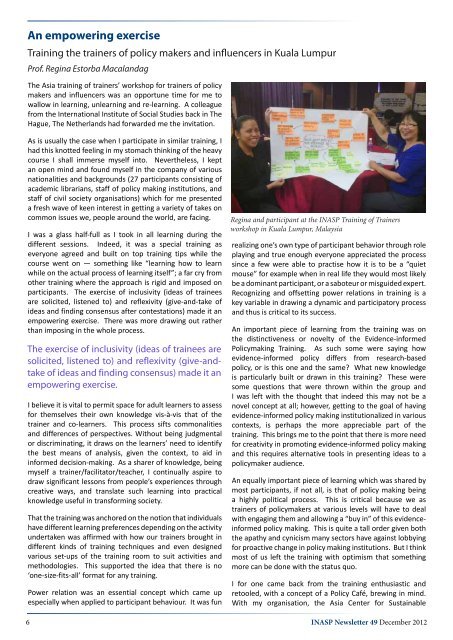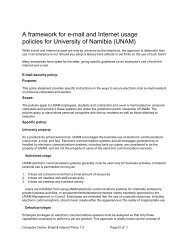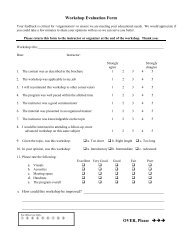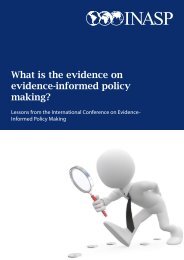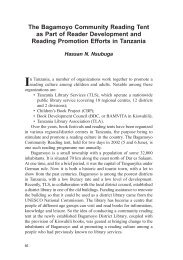INASP newsletter 49.pdf
INASP newsletter 49.pdf
INASP newsletter 49.pdf
You also want an ePaper? Increase the reach of your titles
YUMPU automatically turns print PDFs into web optimized ePapers that Google loves.
An empowering exerciseTraining the trainers of policy makers and influencers in Kuala LumpurProf. Regina Estorba MacalandagThe Asia training of trainers’ workshop for trainers of policymakers and influencers was an opportune time for me towallow in learning, unlearning and re-learning. A colleaguefrom the International Institute of Social Studies back in TheHague, The Netherlands had forwarded me the invitation.As is usually the case when I participate in similar training, Ihad this knotted feeling in my stomach thinking of the heavycourse I shall immerse myself into. Nevertheless, I keptan open mind and found myself in the company of variousnationalities and backgrounds (27 participants consisting ofacademic librarians, staff of policy making institutions, andstaff of civil society organisations) which for me presenteda fresh wave of keen interest in getting a variety of takes oncommon issues we, people around the world, are facing.I was a glass half-full as I took in all learning during thedifferent sessions. Indeed, it was a special training aseveryone agreed and built on top training tips while thecourse went on — something like “learning how to learnwhile on the actual process of learning itself”; a far cry fromother training where the approach is rigid and imposed onparticipants. The exercise of inclusivity (ideas of traineesare solicited, listened to) and reflexivity (give-and-take ofideas and finding consensus after contestations) made it anempowering exercise. There was more drawing out ratherthan imposing in the whole process.The exercise of inclusivity (ideas of trainees aresolicited, listened to) and reflexivity (give-andtakeof ideas and finding consensus) made it anempowering exercise.I believe it is vital to permit space for adult learners to assessfor themselves their own knowledge vis-à-vis that of thetrainer and co-learners. This process sifts commonalitiesand differences of perspectives. Without being judgmentalor discriminating, it draws on the learners’ need to identifythe best means of analysis, given the context, to aid ininformed decision-making. As a sharer of knowledge, beingmyself a trainer/facilitator/teacher, I continually aspire todraw significant lessons from people’s experiences throughcreative ways, and translate such learning into practicalknowledge useful in transforming society.That the training was anchored on the notion that individualshave different learning preferences depending on the activityundertaken was affirmed with how our trainers brought indifferent kinds of training techniques and even designedvarious set-ups of the training room to suit activities andmethodologies. This supported the idea that there is no‘one-size-fits-all’ format for any training.Power relation was an essential concept which came upespecially when applied to participant behaviour. It was funRegina and participant at the <strong>INASP</strong> Training of Trainersworkshop in Kuala Lumpur, Malaysiarealizing one’s own type of participant behavior through roleplaying and true enough everyone appreciated the processsince a few were able to practise how it is to be a “quietmouse” for example when in real life they would most likelybe a dominant participant, or a saboteur or misguided expert.Recognizing and offsetting power relations in training is akey variable in drawing a dynamic and participatory processand thus is critical to its success.An important piece of learning from the training was onthe distinctiveness or novelty of the Evidence-informedPolicymaking Training. As such some were saying howevidence-informed policy differs from research-basedpolicy, or is this one and the same? What new knowledgeis particularly built or drawn in this training? These weresome questions that were thrown within the group andI was left with the thought that indeed this may not be anovel concept at all; however, getting to the goal of havingevidence-informed policy making institutionalized in variouscontexts, is perhaps the more appreciable part of thetraining. This brings me to the point that there is more needfor creativity in promoting evidence-informed policy makingand this requires alternative tools in presenting ideas to apolicymaker audience.An equally important piece of learning which was shared bymost participants, if not all, is that of policy making beinga highly political process. This is critical because we astrainers of policymakers at various levels will have to dealwith engaging them and allowing a “buy in” of this evidenceinformedpolicy making. This is quite a tall order given boththe apathy and cynicism many sectors have against lobbyingfor proactive change in policy making institutions. But I thinkmost of us left the training with optimism that somethingmore can be done with the status quo.I for one came back from the training enthusiastic andretooled, with a concept of a Policy Café, brewing in mind.With my organisation, the Asia Center for Sustainable6 <strong>INASP</strong> Newsletter 49 December 2012


